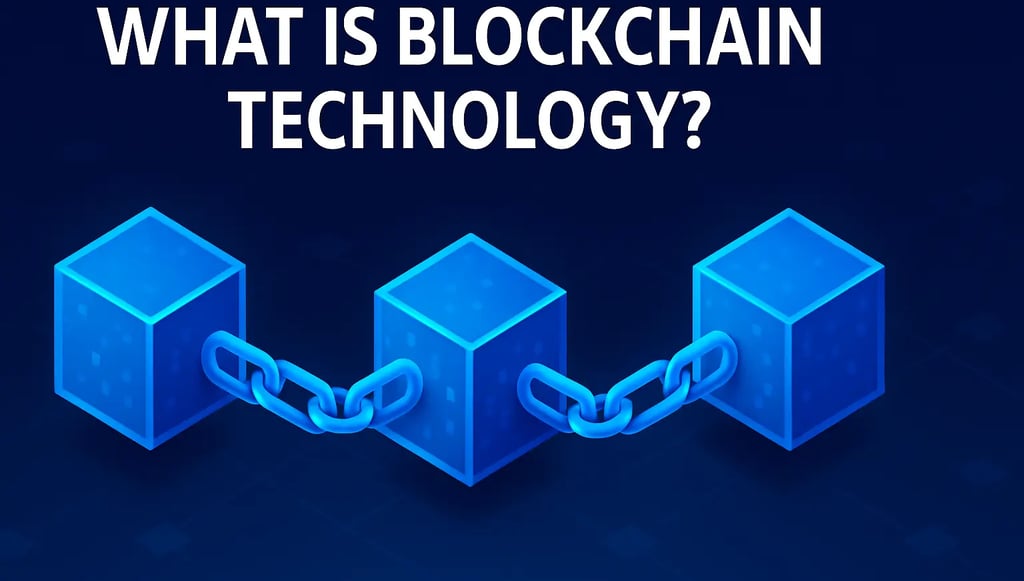What is Blockchain Technology? Benefits, Working, and Future Trends Explained
Discover what blockchain technology is, how it works, its key benefits, real-world applications, and future trends. Learn why blockchain is revolutionizing industries like finance, healthcare, and logistics.


🔗 What is Blockchain Technology?
Blockchain is a revolutionary digital technology that functions as a decentralized ledger system, ensuring secure, transparent, and tamper-proof transactions.👉 Learn the fundamentals of blockchain to see how it differs from centralized databases. Unlike traditional databases controlled by a central authority, blockchain distributes data across a network of computers (nodes), making it resistant to fraud and manipulation.
Each piece of data is recorded in a block, and these blocks are chronologically connected to form a continuous “chain.” Every block includes a cryptographic hash of the previous block, a timestamp, and transaction data—making it virtually impossible to alter past records without detection.
Blockchain was first introduced in 2008 by Satoshi Nakamoto as the backbone of Bitcoin.👉 Read the original Bitcoin whitepaper to explore how it all began. Though initially used in cryptocurrencies, its applications have now extended across finance, supply chains, healthcare, and governance due to its unmatched data integrity and security features.
⚙️ How Does Blockchain Work?
Blockchain operates as a decentralized digital ledger where each transaction is grouped into a “block.” Once verified, this block is added to the chain in a secure and chronological order.
🔐 Consensus Mechanisms
Blockchain relies on consensus algorithms to validate transactions. Two popular mechanisms are:
Proof of Work (PoW): Used in Bitcoin, it involves miners solving complex mathematical puzzles to validate and add blocks. While secure, it consumes high energy.
Proof of Stake (PoS): Validators are chosen based on the number of coins they stake, making it more eco-friendly and scalable. 👉 Compare PoW vs PoS on Ethereum.org
🛡️ Cryptographic Hashing
Every transaction is encoded using a hash function, generating a unique identifier. Even a small data change alters the hash, alerting the network and preventing tampering.
These mechanisms ensure that blockchain transactions are transparent, immutable, and secure, making it ideal for use cases like cross-border payments, smart contracts, and digital identity verification.
✅ Key Features and Benefits of Blockchain
Blockchain technology offers several standout features that enhance security and efficiency across industries:
1. Transparency
Every participant in the blockchain network has access to the same information, allowing real-time verification of transactions. This openness builds trust and reduces fraud.
2. Immutability
Once recorded, data on the blockchain cannot be altered. This permanent record is invaluable in sectors like finance and legal, where data integrity is critical.
3. Security
Data is encrypted and spread across multiple nodes, making unauthorized access or manipulation virtually impossible. This is especially useful in protecting health records, supply chains, and digital identities.
In the healthcare industry, blockchain can streamline patient data management and enhance security. 👉 Read WHO’s digital health overview on how technologies like blockchain transform healthcare systems.
4. Efficiency and Cost Reduction
Blockchain eliminates the need for intermediaries, streamlining processes and reducing operational costs in banking, insurance, and logistics.
🌍 Real-World Applications
Supply Chain: Real-time product tracking and verification
Healthcare: Secure patient data sharing
Voting Systems: Transparent and tamper-proof digital voting
Banking: Fast, cross-border transactions without third-party fees 👉 Explore live blockchain data
📈 Future Trends and Challenges in Blockchain
🔄 Scalability Improvements
Popular networks like Ethereum face challenges with slow speeds and high fees. Innovations such as Layer 2 solutions, sharding, and advanced consensus models are being developed to scale performance.
🧾 Regulatory Frameworks
As blockchain gains global attention, countries are implementing regulatory policies to address cryptocurrency use, DeFi platforms, and smart contracts—balancing security with innovation.
💸 Rise of Decentralized Finance (DeFi)
DeFi platforms eliminate intermediaries, offering users greater access to loans, savings, and insurance products. While promising, this sector faces risks related to smart contract vulnerabilities and lack of regulation.
🔌 Technical and Ethical Challenges
Interoperability: Ensuring different blockchains can communicate
Energy Consumption: Especially with PoW systems
Privacy vs. Transparency: Managing user data ethically
🚀 Conclusion
Blockchain is more than just the backbone of cryptocurrencies—it's a transformational technology set to redefine how we manage data, trust, and digital transactions. With its core features of decentralization, transparency, and security, blockchain is already creating waves in industries like finance, healthcare, and logistics.
As it continues to evolve, solving scalability and regulatory challenges will be crucial to unlocking its full potential. The future of blockchain is not only promising—it's already here.
